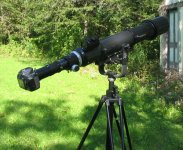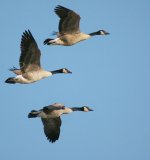I have recently purchased a sigma 500f4.5, and am still getting used to it's handling. It's a bit heavy for prolonged handholding, so I also got a manfrotto 393 head. Up until today I had only used the lens, whether tripod-mounted or handheld, on static or slow moving subjects, but after reading a thread on the 40D and BIF I felt I needed to test myself with the new kit.
So... camera and lens mounted on gimbal head, trying to track swallows and martins as they zoomed along the water's edge at a local reservoir should be a good learning experience! They were coming in fast and close - indeed a few birds flew between the legs of my tripod! Even tracking the little rockets was hard, let alone keeping a focus lock, but after 30mins or so, I was beginning to get some reasonable results (about 5 shots out of 80!)
I've solved some of the problems - have the 2-leg side of the tripod base facing you so as you dont trip over the rear leg; start tracking a fast-moving bird when it's still heading away from you, and follow it's flight path back round (otherwise it's gone before you've found it!). With these birds, which were very mobile and eratic even when on a relatively predictable general flight path, I found having all the focus points active worked best, except perhaps when they headed straight in towards the camera - in this case the centre point only was better if I could keep it on the bird!
Here's my best efforts from today - I'm still learning how to handle this set-up, so any pearls of wisdom will be gratefully received.
http://www.birdforum.net/gallery/showphoto.php/photo/158823/ppuser/28570
http://www.birdforum.net/gallery/showphoto.php/photo/158824/ppuser/28570
http://www.birdforum.net/gallery/showphoto.php/photo/158825/ppuser/28570
So... camera and lens mounted on gimbal head, trying to track swallows and martins as they zoomed along the water's edge at a local reservoir should be a good learning experience! They were coming in fast and close - indeed a few birds flew between the legs of my tripod! Even tracking the little rockets was hard, let alone keeping a focus lock, but after 30mins or so, I was beginning to get some reasonable results (about 5 shots out of 80!)
I've solved some of the problems - have the 2-leg side of the tripod base facing you so as you dont trip over the rear leg; start tracking a fast-moving bird when it's still heading away from you, and follow it's flight path back round (otherwise it's gone before you've found it!). With these birds, which were very mobile and eratic even when on a relatively predictable general flight path, I found having all the focus points active worked best, except perhaps when they headed straight in towards the camera - in this case the centre point only was better if I could keep it on the bird!
Here's my best efforts from today - I'm still learning how to handle this set-up, so any pearls of wisdom will be gratefully received.
http://www.birdforum.net/gallery/showphoto.php/photo/158823/ppuser/28570
http://www.birdforum.net/gallery/showphoto.php/photo/158824/ppuser/28570
http://www.birdforum.net/gallery/showphoto.php/photo/158825/ppuser/28570





